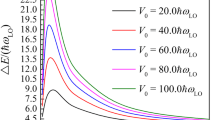Abstract
Selecting the asymmetric Gaussian (AG) potential to describe the confinement of electron in a disk-shaped quantum dot (QD), the ground state and the first excited state energy and wave function of the system are derived by using the Lee\(\hbox {--}\)Low\(\hbox {--}\)Pines (LLP) Pekar transformation variational method, and the two-level structure required for a qubit is constructed. The influence of material parameters such as the dispersion coefficient, dielectric constant ratio and electron\(\hbox {--}\)phonon coupling constant on the qubit properties of AG potential QD with the electromagnetic field are investigated. The results show that the electric field and magnetic field have opposite adjustment functions for the formation of qubit. The electric field is advantageous for the qubit survival and information storage, while magnetic field and electron\(\hbox {--}\)phonon coupling are detrimental to the qubit survival and information storage, respectively. The decoherence time of the qubit increases with increasing magnetic field cyclotron frequency ‘from the turning point’. Applying an electric field, increasing the dielectric constant ratio, the dispersion coefficient and the electron\(\hbox {--}\)phonon coupling constant of the materials are all beneficial to improve the coherence of the qubit.


















Similar content being viewed by others
References
M Tiotsop et al, Iran. J. Sci. Technol. Trans. Sci. 42, 933 (2018)
Z H Lang, C U Cai and J L Xiao, Int. J. Theor. Phys. 58, 2320 (2019)
D Misra and S K Tripathy, Pramana – J. Phys. 86, 661 (2016)
M Ávila and J Rueda-Paz, Pramana – J. Phys. 86, 777 (2016)
Z H Liang and J L Xiao, Indian J. Phys. 92, 437 (2018)
S S Li et al, J. Appl. Phys. 90, 6151 (2001)
J R Petta et al, Science 309, 2180 (2005)
S Varwig et al, Phys. Rev. B 87, 115307 (2013)
Y Sun and J L Xiao, Opt. Quant. Electron. 51, 110 (2019)
J L Xiao, J. Low Temp. Phys. 195, 442 (2019)
X Ma and J L Xiao, Opt. Quant. Electron. 5, 144 (2018)
J L Xiao, J. Low Temp. Phys. 192, 41 (2018)
F M Peeters and V A Schweigert, Phys. Rev. B 53, 1468 (1996)
W F Xie, Commun. Theor. Phys. 42, 151 (2004)
J Adamowski et al, Phys. Rev. B 62, 4234 (2000)
J Gu and J J Liang, Acta Phys. Sin. 54, 5335 (2005) (in Chinese)
T D Lee, F M Low and D Pines, Phys. Rev. 90, 297 (1953)
S I Pekar, Untersuchungen über die Elektronen-theorie der Kristalle (Akademie Verlag, Berlin, 1954)
A J Fotue et al, Eur. Phys. J. Plus 131, 75 (2016)
X F Bai et al, J. Korean Phys. Soc. 70, 956 (2017)
Wuyunqimuge et al, J. Low Temp. Phys. 193, 48 (2018)
Acknowledgements
This work was supported by National Natural Science Foundation of China under Grand No. 51902085 and the Natural Science Foundation of Inner Mongolia Autonomous Region, China under Grant No. 2019MS01011 and Grant No. 2019MS06017.
Author information
Authors and Affiliations
Corresponding author
Rights and permissions
About this article
Cite this article
Wuyunqimuge, Xin, W., Liu, XX. et al. Influence of the dispersion coefficient and dielectric constant ratio on the asymmetric Gaussian potential quantum dot qubit with electromagnetic field. Pramana - J Phys 94, 98 (2020). https://doi.org/10.1007/s12043-020-01963-4
Received:
Revised:
Accepted:
Published:
DOI: https://doi.org/10.1007/s12043-020-01963-4




